OUTCOME 4: PROCEDURES
Effective and Coherent Implementation of MRC Procedures by the MRC Member Countries
INDICATORS:
• Evidence of adverse transboundary impacts that were mitigated, minimised, or avoided in basin planning and management by using the MRC procedures • Number of water utilisation projects notified and consulted on, and improved agreement under the consultation and notification process of the PNPCA • Evidence of actions taken under the PWQ and the PMFM when water flows, levels and quality are at critical levels • The amount of data and information under the PDIES that are shared and used for basin development planning and management, and research purposes • The number of projects monitored under the PWUM at both the national and regional levels,
HIGHLIGHTS The MRC’s procedural frameworks are an indispensable aspect of the MRC’s water diplomacy platform, providing both an obligatory and enabling environment for cooperating on data sharing, monitoring, project notification and consultation, and maintaining an acceptable flow regime and water quality. The five MRC Procedures – the PDIES, PWUM, PMFM, PWQ and PNPCA – represent the most comprehensive set for water management on an international river in the developing world. The PDIES allows data sharing and exchange among MCs, resulting in the availability of an extensive amount of data to the public, researchers, and partners around the world. The PMFM and the PWQ provide basis for the critical work in monitoring water flow and water quality. While water use monitoring per PWUM has not been operationalized yet, some work was completed by the end of 2020 to conceptualize its implementation in the next strategic planning period. Finally, while the implementation of the prior consultation process of the PNPCA had seen its challenges and, to some, even failures earlier, it turned around during the period of 2016–2020 with an innovative approach towards concrete results in improving project design, and enhancing the process itself with greater understanding, transparency, accountability and agreements. The introduction of the Joint Statement and the JAP as concrete agreed outputs of the PC process has elevated the cooperation among the MCs and assured the process a deliberate and action-oriented conclusion. It has also increased both the commitment of the proposing country and the confidence of notified countries that projects that passed through the PNPCA would be implemented sustainably. The PNPCA process has contributed to reducing tensions among countries from ten years ago and ushered in a new climate of cooperation in finding solutions together. Finally, with Xayaburi, Pak Beng, Pak Lay, Luang Prabang, and Sanakham HPPs representing a cascade of dams, there is an increasing recognition that cascade coordination and management have become a key issue. This is reiterated in the next strategic planning cycle in which the BDS 2021–2030 places stronger emphasis on improving the coordination of basin management operations to increase positive transboundary effects and mitigate negative impacts.
Procedures for Data, Information Exchange and Sharing
──────────────────────────────────────────────────────────
The purpose of the Procedures for Data, Information Exchange and Sharing is to establish a repository of data on the Mekong River Basin the tools that can be used to assess any potential impacts of developments in the Basin.
──────────────────────────────────────────────────────────
To operationalize the PDIES, promote data and information exchange among the four MRC MCs, and provide data and information access to the public, the MRC-IS was established and operated as regional knowledge hub in 2005 and subsequently the Data Portal in 2010 to facilitate data access. In June 2019, a new version of the Data Portal was launched with enhanced data and information services, a streamlined data request process, and user experience, and an overall improvement in system performance and functionalities as a result of integrating AQUARIUS for time-series visualization, a new GeoServer system-Web Map Service for map visualization, and a PostgreSQL database management system for data access by sector. The updated Data Portal was also designed for seamless data integration and harmonization with National Mekong Committee Information Systems (NMC-IS) in line with the Reinvigoration Design Concept.
The MRC-IS/Data Portal currently stores and provides access to a total of 10,333 datasets, of which 3,659 consist in time-series data collected from 892 monitoring stations over 110 years. The data are categorized into the 12 major groups/types of data and information required for implementation of the MRC programme/activities and Mekong Agreement, inter alia: • Water resources (3,590 datasets) • Topography (7 datasets) • Natural resources (94 datasets) • Agriculture (2958 datasets) • Navigation and transportation (1) • Flood management and mitigation (399 datasets) • Infrastructure (7 datasets) • Urbanization/industrialization • Environment/ecology (4,458 datasets) • Administrative boundaries (3,630 datasets) • Socio-economy (647 datasets) • Tourism. As of this writing, the MRC-IS/Data Portal has over 11,000 registered users categorized into four major groups as shown in Figure 27.
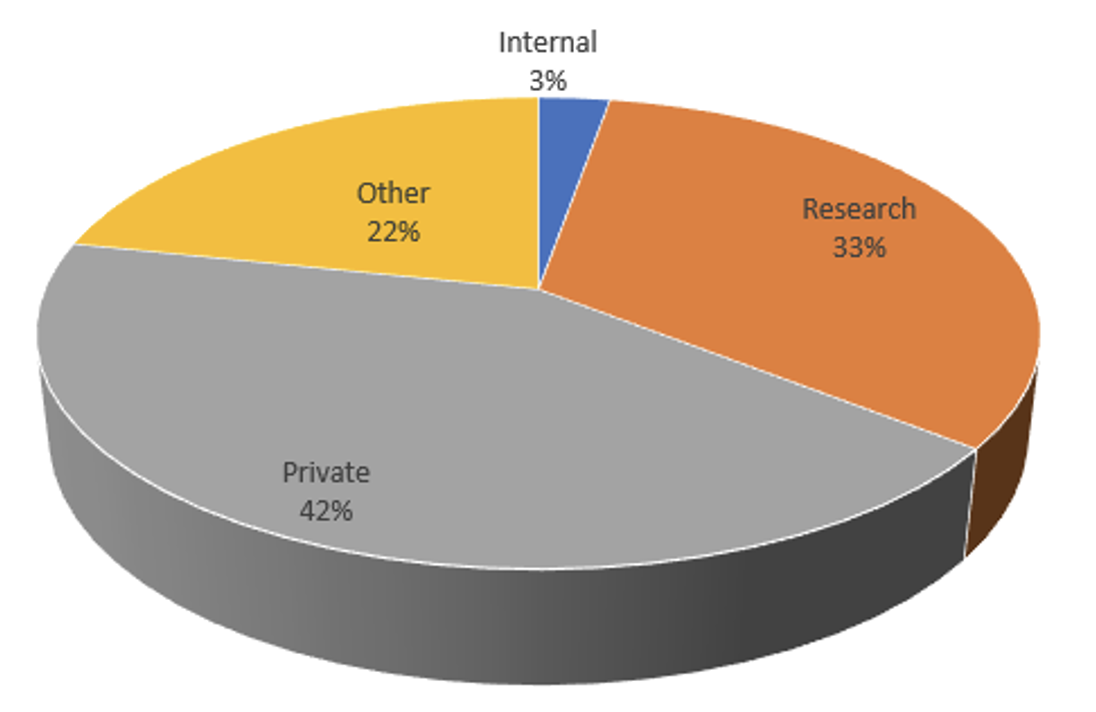
Figure 27. Percent distribution of the 11,000 registered users of the MRC-IS/Data Portal

Procedures for the Maintenance of Flows on the Mainstream
─────────────────────────────────────────────── The purpose of the Procedures for the Maintenance of Flows on the Mainstream (PMFM) is to ensure that there is sufficient water in the mainstream to support pre-existing and previously notified (for prior consultation) downstream water use, as well as the reverse flow into the Tonle Sap, throughae the active management of storage. Similarly, active management of storage is required to ensure that flood disasters are not exacerbated.
───────────────────────────────────────────────
The PMFM has been implemented for routine monitoring of the flow regime, and for checking compliance of agreed thresholds during the PC process for proposed mainstream projects. These agreed thresholds include the following: • not less than the acceptable minimum monthly natural flow during each month of the dry season is maintained in the mainstream; • an acceptable natural reverse flow of the Tonle Sap River occurs during the wet season; and • average daily peak flows greater than what naturally occur on the average during the flood season are prevented. A dedicated website for the PMFM is fully operational and provides a highly useful tool for the monitoring and warning of usual flow situations (see Figure 28).
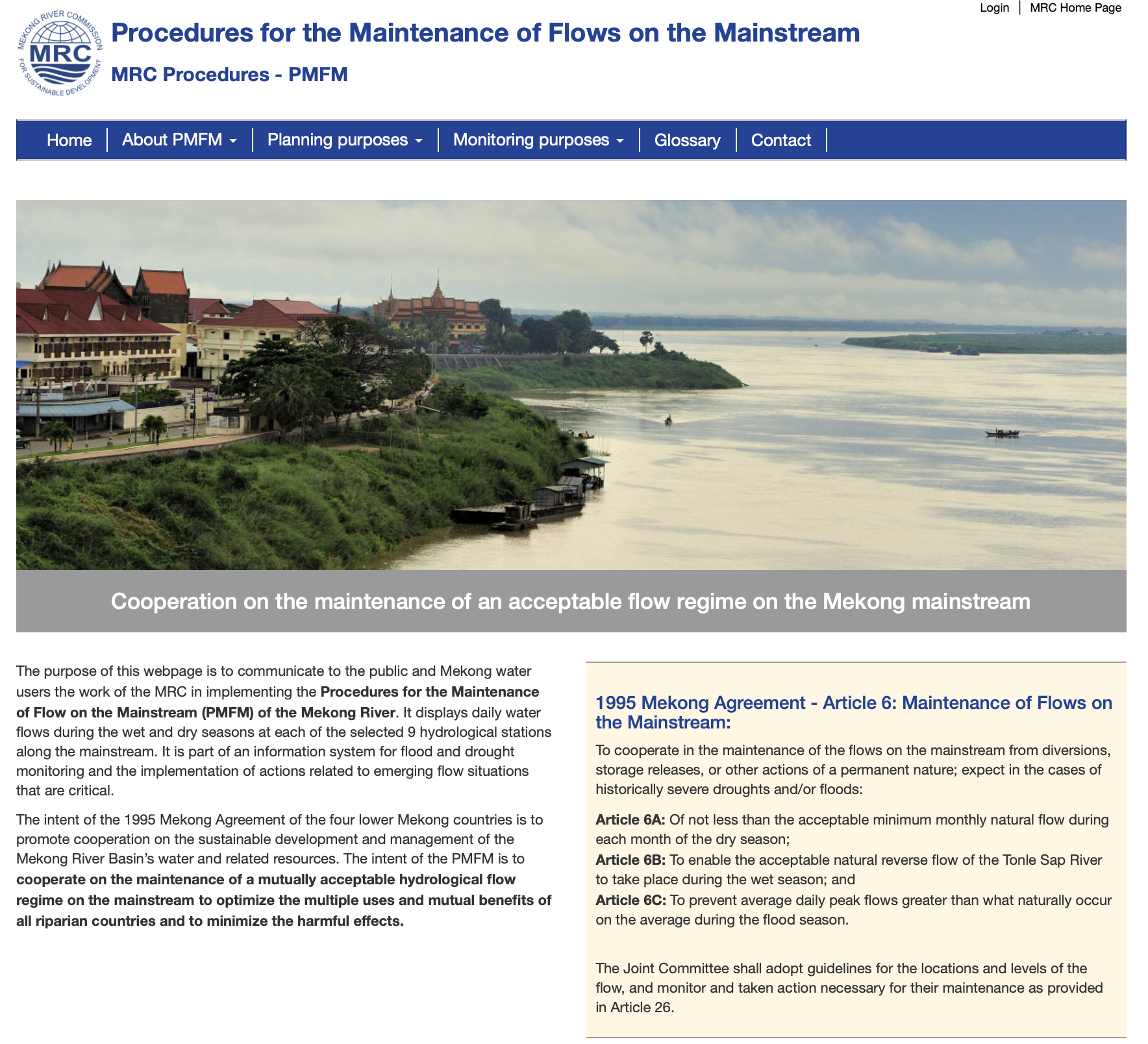
Figure 28. The PMFM Website
The Procedures for Water Quality
─────────────────────────────────────────────────────────────────
The purpose of the Procedures for Water Quality is to monitor and report on the water quality status of the Mekong River System against agreed criteria for human use and aquatic ecosystems. The Procedures also outline the protocols for reporting emergency situations
─────────────────────────────────────────────────────────────────
Preserving the Mekong River’s water quality is essential to secure the health of riverine communities and the future of the river’s aquatic life. The PWQ defines two types of action to maintain water quality at acceptable levels for humans, flora, and fauna: (1) water quality monitoring; and (2) emergency response. The PWQ Technical Guidelines on the Implementation of the Procedures for Water Quality (Technical Body for Water Quality, TBWQ) has two parts: Part 1 on routine water quality monitoring, and Part 2 on emergency water quality responses. Routine water quality monitoring, which is conducted by the appropriate line/implementing agencies of the MCs, subsequently began in 2010. Technical guidelines for the establishment of an emergency response and management system were developed in 2017. The guidelines recognize existing mechanisms for emergency responses to natural disasters developed by ASEAN. To avoid establishing two parallel emergency responses in the Basin, the MRC has been working with ASEAN to develop standardized regional emergency response mechanisms that meet national, transboundary and regional needs for water quality disaster control.
The Procedures for Water Use Monitoring
─────────────────────────────────────────────────────────────────
The purpose of the Procedures for Water Use Monitoring(PWUM) is to establish a reasonable and equitable use of the water against which future uses can be evaluated. It must serve as a record of the use of water, and a record of the use of the water by the project begins. The PWUM must therefore follow the PNPCA and must include identification and monitoring of the measures put in place to avoid, minimize and mitigate impacts.
─────────────────────────────────────────────────────────────────
The objective of the PWUM is to provide a comprehensive and adaptive framework and process to support effective implementation of the intra-basin water use monitoring and the monitoring of inter-basin diversions. This includes establishing existing (pre-1995) water uses so that they can be protected and maintained when new water uses are put in place, which is one of the factors to consider when evaluating reasonable and equitable use. In addition, any subsequently notified (i.e. through the PNPCA) water uses will be accommodated in the future development of the Basin. These uses have been captured in the DSF used by the MRC, which are used in basin planning. The Xayaburi and Pak Beng prior consultation processes have also led to proposals for design and operational changes, and in the case of Xayaburi, some of the design changes have already been implemented. The PWUM are therefore implicitly being implemented through the DSF and PNPCA. An additional challenge for the PWUM is that the scope of water use is not fully defined. A concept to operationalise PWUM was prepared and consulted with MCs in 2020 and will be further worked on in the next MRC SP period.
The Procedures for Notification, Prior Consultation and Agreement
─────────────────────────────────────────────────────────────────
The purpose of the Procedures for Notification, Prior Consultation and Agreement is both to establish a record of water uses that may have an impact on the mainstream and which were initiated after 1995, as well as to provide a basis for discussions of proposed uses that could have greater impacts, with a view to the reasonable and equitable use of the Mekong River System.
─────────────────────────────────────────────────────────────────
To harness the Mekong River Basin’s full potential for development, the Mekong countries have begun building bridges, large-scale irrigation and flood control structures, and hydropower along the mainstream and tributaries. The PNPCA established a regional cooperation mechanism over planned water development aimed at optimising the use of water resources for development while minimising potential adverse transboundary impacts. The PNPCA requires any Member Country planning a water development project that may significantly alter water flow or quality of the Mekong mainstream to undergo one of the three processes: Notification, Prior Consultation, or Specific Agreement. During the five-year SP period of 2016–2020, 13 notifications (9 notifications, and 4 prior consultations) were made (10 HPPs in Lao PDR, 2 flood and drought management projects for irrigation in Thailand, and a bridge project in Viet Nam), making for a total of 55. As shown in Figure 29, there are currently a total of 76 notifications, 55 of which are PNPCA notifications, and 21 are only initial information.
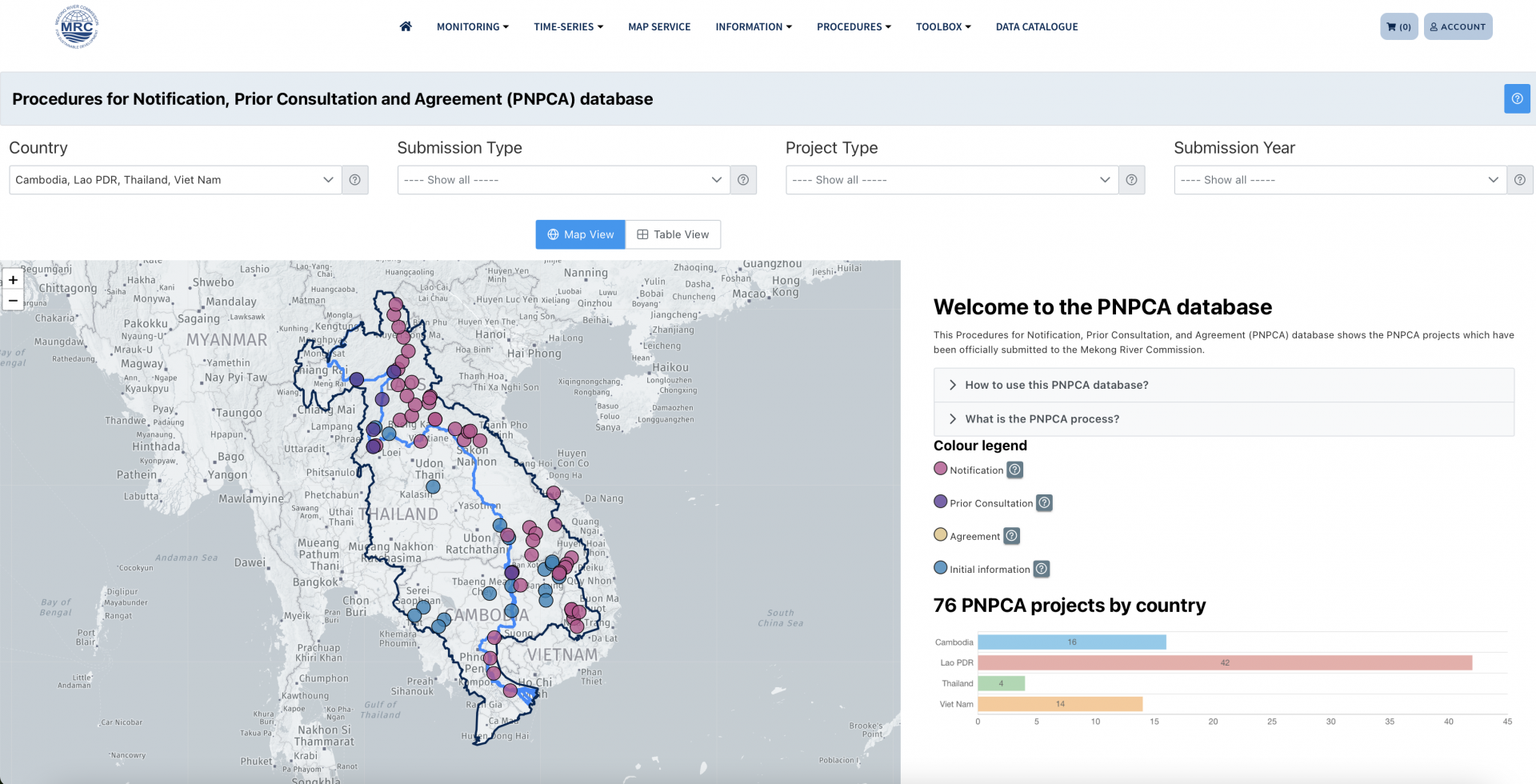
Figure 29. PNPCA projects by country
Source: MRC PNPCA data source accessible at https://portal.mrcmekong.org/pnpca-projects/map
Prior to the strategic planning cycle 2016–2020, the Prior Consultation (PC) of the PNPCA was used for the Xayaburi hydropower dam in 2010–2011 and the Don Sahong dam in 2014–2015. While each PC resulted in positive changes in the design of the dams to address the concerns raised by MCs and relevant stakeholders, they both ended with no formal agreements achieved among the MCs. Instead, the Xayaburi and Don Sahong projects ignited the most intense debates over water resources development in the Mekong, pitting countries against one another and contestations and protests from civil society, and even Development Partners. One country suggested through the media to use the international court to resolve the disputes, and another country officially recommended a 10-year deferment of constructing dams on the mainstream. Intent on improving the process, MRC Secretariat worked hard with MCs to timely release documents, provide a forum to consult stakeholders early, and introduce two desired outputs of the PC, starting with the Pak Beng HPP in 2017: the Joint Statement and the JAP. Following a number of informal and formal meetings, both at technical and high level, and through bilateral and multilateral channels, the PC for the Pak Beng HPP concluded with an agreed Statement by the Joint Committee, which included key recommendations to avoid, minimize and mitigate potential transboundary impacts and increase potential benefits. The JAP was also subsequently agreed as a post-consultation mechanism to ensure that the Joint Statement would be implemented after the end of the six-month PC. The JAP enables exchange and dialogues among the notifying and notified countries and the MRC to improve the proposed project. The introduction of the Joint Statement and the JAP for the Pak Beng HPP has resulted in the successful conclusions of the subsequent Prior Consultations for Pak Lay HPP in April 2019, and Luang Prabang HPP in June 2020. The PC for the Sanakham HPP, which began in June 2020, is scheduled to be completed in 2021. It should be noted that the Prior Consultations for Luang Prabang and Sanakham HPPs took longer than the standard duration of six months due to the COVID-19 pandemic. In addition, the pandemic also prevented face-to-face interactions both at the national and regional levels, which to some extent negatively impacted the quality and effectiveness of the consultations. The Sanakham HPP was also hampered by lack of and outdated data and information with the submitted documents, in particular those related to the transboundary impact assessment. This was exacerbated by the strong concern expressed by Thailand over the project’s impact on the livelihood of Thai communities in the border, which is of close proximity to the project. Overall, the successful conclusions of the Prior Consultations demonstrate the increased confidence of the MCs on the mechanism of the Statement and the JAP to push for sustainable hydropower development in an open and inclusive matter. The JAP tracking matrices for the PBHPP, PLHPP and LPHPP post-consultation implementation were completed and agreed by the MCs in November 2020.
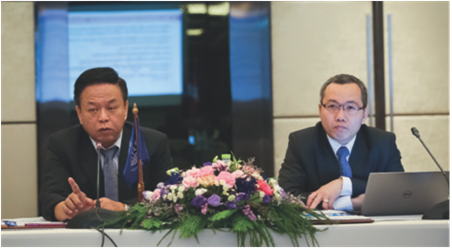
Chairperson of the MRC Joint Committee for 2019 Dr Le Duc Trung of Viet Nam (left) and CEO of the MRC Secretariat Dr An Pich Hatda (right) facilitate the Joint Committee Special Session held in Vientiane, Lao PDR to conclude the six-month Prior Consultation process for the Pak Lay HPP (4 April 2019).
Evidence of change
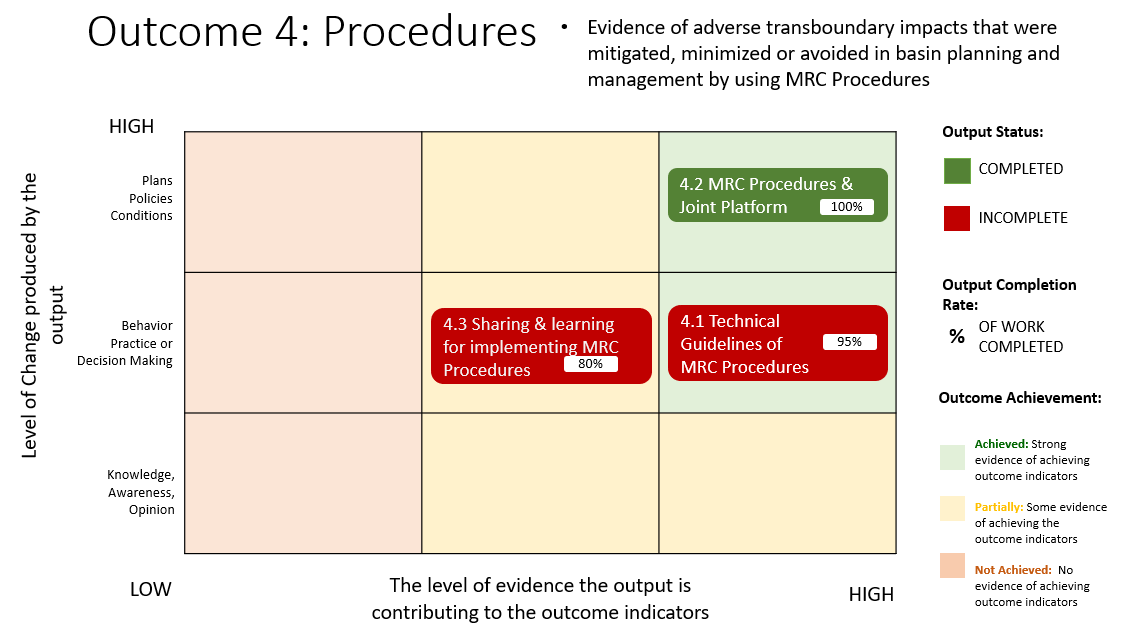
Figure 30. Outcome Evaluation Matrix
Note: The Matrix assesses outcome achievement based on output completion and the type of change that occurred – Outcome 4
Increase in Knowledge and Understanding The increase in knowledge and understanding of the broader stakeholders such as the hydropower developers and the public has also led to the more effective, less contentious and less controversial implementation of the MRC Procedures, including for such a political and public process as the PC for proposed mainstream dams (see Figure 31). The PNCPCA Prior Consultation (PC) for the HPPs during the period 2016–2020, due to the increased awareness and understanding of the process among all PC participants, has led to more constructive interactions by all. There is increasing evidence that the developers are becoming more proactive, for example, by reviewing the PDG 2009 in advance of the PC and making the necessary adjustments to increase the alignment of their hydropower design. The hydropower developers are also becoming more responsive. For instance, the developers for the Xayaburi and the Luang Prabang HPPs have been cooperative in exchanging information and dialogue, and supplying additional documents. The PLHPP developer (Power China) provided additional documents related to China’s standards for dam safety in response to the MRC Secretariat’s request. With Xayaburi, Pak Beng, Pak Lay, and Luang Prabang dams representing a cascade of dams, there is also an increasing recognition that cascade operation and management have become key issues. The Lao Government also recognizes the importance of these issues, and has conducted a study with financial support from France and technical support from Compagnie Nationale du Rhône (CNR) on the feasibility of establishing a Coordination Monitoring Centre to serve as a state agency dedicated to the management of HPPs in Lao PDR. The Development Partners have been also encouraged by the innovative evolution of the PC process, the increasing commitment of the proposing country (Lao PDR), and the MRC’s efforts in facilitating the participation of different stakeholder groups during the PC process. “We reiterate our appreciation of the work of the Secretariat throughout the Prior Consultation process for the Pak Beng hydropower project, and welcome the Member Countries’ first Joint Statement on a proposed mainstream hydropower project.” – Joint Statement of the MRC Development Partners, November 2017 While some stakeholder groups question the nature of the PC process, which in their view does not result in their preferred outcome, many stakeholders do appreciate the usefulness of the process. Writing for the NGO International Rivers’ publication, an independent observer noted: “The MRC provided a forum for discussion and conflict resolution that was observable in real time by civil society organizations, media, donors, academics and other interested parties. Without the MRC and its PNCPA process, there would have been a lack of procedures and guidelines to facilitate regional discussion of the impact of large-scale infrastructure. There would also have been a lack of transparency of planning, publicly accessible project documents, and various forms of research made available via the MRC website. The MRC, therefore, provided an important channel of communication, discussion, research, and information dissemination.” – Dr Oliver Hensengerth, quoted as saying in Expert Commentary on ‘Review of Design Changes Made for the Xayaburi Hydropower Project (Oakland, USA: International Rivers, 2019).
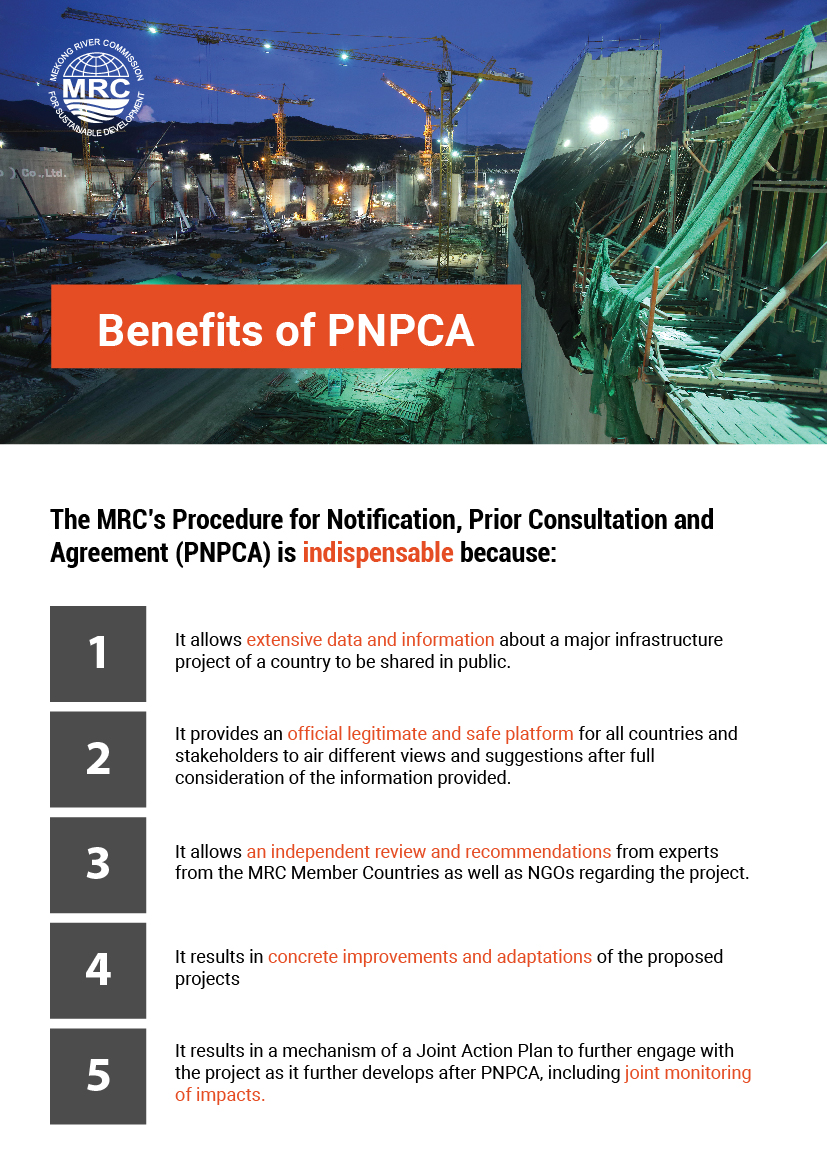
Figure 31. Benefits of the PNPCA
Use in Regional and National Planning and Decision-Making The MRC Procedures and their respective Technical Guidelines have been applied to the various regional and nationally led activities by the MRC. The PDIES has led to the continuous operation, maintenance, and use by the MCs and broader stakeholders of the MRC’s Data Portal to support data and information needs. Its implementation covers both central and decentralized core monitoring functions, thereby assuring the continuous operation, maintenance, and expansion of the hydrological and environmental monitoring network and the flood and drought forecasting services. The PMFM has led to the continuous operation and maintenance of the PMFM website, which serves as a useful reference for fostering clarity and transparency in managing and maintaining required flows in the mainstream. The MRC Secretariat regularly provides alerts to MCs on the possible non-compliance with the agreed monitoring thresholds of the PMFM, and the necessary actions that should be taken. The PWQ and its Technical Guidelines has ensured the continuous regular monitoring of water quality of the Mekong River and the preparation of regional annual WQM reports. The MRC Secretariat regularly provided alerts to MCs on the unusual water quality issues, as well as the investigations and actions that were needed. The PNPCA continues to be complied with and used by MCs, both in notifications of projects and prior consultation. The improved implementation of the Prior Consultations for PBHPP, PLHPP, and LPHPP has been instrumental in elevating the cooperation among the MCs, reducing tensions, and concluding the PC process successfully with formal agreements on follow-up monitoring and mitigation actions.
Selected Questions and Answers on Stakeholders’ Participation in the PNPCA PC Process How does the PC Process provide equal opportunity for all stakeholders to participate, especially civil society organizations (CSOs) and affected communities? • The PC process by design is open, transparent, and inclusive as agreed by the MCs and facilitated by the MRC Secretariat. This helps ensure that all stakeholders are given the opportunity to participate. The regional consultation is an open invitation to the public. Some financial support is provided to CSOs if warranted. While direct engagement with potentially affected local communities is still limited, their voices are represented by the CSOs, and when applicable, by their representative local government/administration. In addition, an online platform (MRC website/social media) is established to allow any public comments/views to be heard and recorded during the PC process. How are inputs/comments by stakeholders taken into account? • Inputs and comments from civil society and other stakeholders via various platforms, such as consultations at national and regional levels, online comments are well documented in a comment matrix as one of the annexes of the Technical Review Report (TRR). • Within the PNPCA PC process, during meetings of the JCWG, comments gathered from national and regional consultations are presented and taken into account by the experts in formulating/revising the TRR. • TRR is used as a basis by each NMC in formulating their respective national Reply Form, which highlights the national decision and position with regard to the proposed project. • TRR is also used by the MRC JC to discuss and support their decision at the end of the process including the Statement and JAP. How are communication barriers due to lack of local language translations handled/mitigated? • The MRC provides a number of documents in riparian languages, such as the Project Overview, and the Summary of the draft TRR. They are shared to facilitate the national and regional information sharing and consultations. To keep the public informed, the outcomes of major meetings as key milestones of the PC process are shared through the MRC’s website in the form of a Press Release, which is made available in all riparian languages. How is the due diligence of the Proposing Country and Developers assured with respect to quality implementation and transparency of the information of the proposed project during both prior consultation and post-Prior Consultation processes? • Within the PC process, in addition to the JCWG Meeting and Regional Consultation, at least three technical meetings with the Proposing Country and the developer are conducted to discuss data/information and technical aspects of the submitted project, as well as comments and recommendations made by the MRC Secretariat in the TRR. • As agreed by the MCs (through the MRC JC), JAP implementation is reported as a standing agenda of the regular MRC Joint Committee Meeting to update other MCs with the concerns/comments and recommendations in the TRR, and any changes in the design, construction, and operation of the proposed project. • To implement the JAP, regular meetings between the MRC Secretariat and the Proposing Country’s concerned agencies are conducted to get updates on the status of the project development and how they align with the agreed Statement and the JAP.